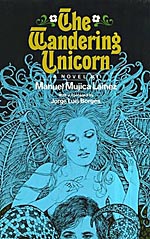
![]() Rhondak101
Rhondak101
11/4/2014
![]()
The forward to Manuel Mujica Lainez's The Wandering Unicorn is written by Jorge Luis Borges. This is significant because much of the book reminds me of Borges. However, this book is not as elliptical as Borges' writings and its use of history is much more traditionally presented than Borges'.
The narrator of The Wandering Unicorn is the fairy Melusine. (If you don't know who Melusine is or what she looks like, take a look at the double-tailed "mermaid" on your Starbucks cup.) Melusine was a beautiful fairy, who was cursed so that on Saturdays she grew wings and two tails. She had to keep her husband from seeing her in this condition. If he did, she would be stuck in this way permanently. Of course, this happened in Mujica Lainez's version. During the events of the book Melusine has been in this condition for hundreds of years. However, although her shape remains the same, she is able to be invisible. Therefore, she often exists among people but never interacts with them.
The book opens in 1174, and Melusine is sitting in her abandoned tower, watching her descendants. She is the matriarch/progenitor of the powerful dukes of Lusignan. Along the road comes a knight-errant and a group of traveling player, and through a series of coincidences that could only occur in a novel of magic realism (or a soap opera), Melusine learns of two descendants that she did not know she had, one of which is the spitting image of her long dead husband.
The invisible Melusine throws her lot in with these new, exciting Lusignans and accompanies them through France and then all the way to the Crusader kingdom in Jerusalem. They never know that she is along shaping their lives and fulfilling her own desires. Surprisingly, many things can happen when an invisible, immortal fairy falls in love with her teen-aged multiple-great grandson.